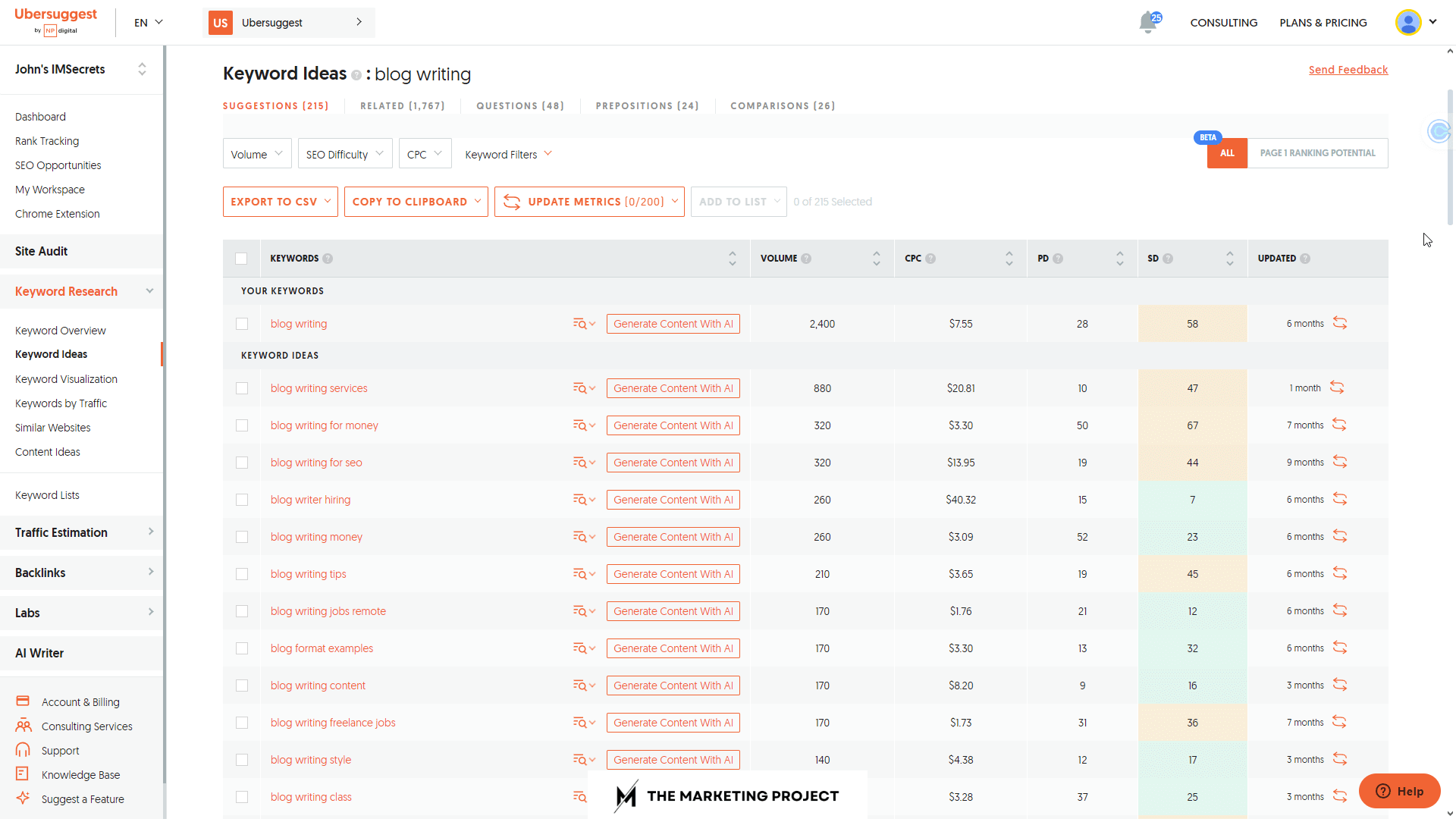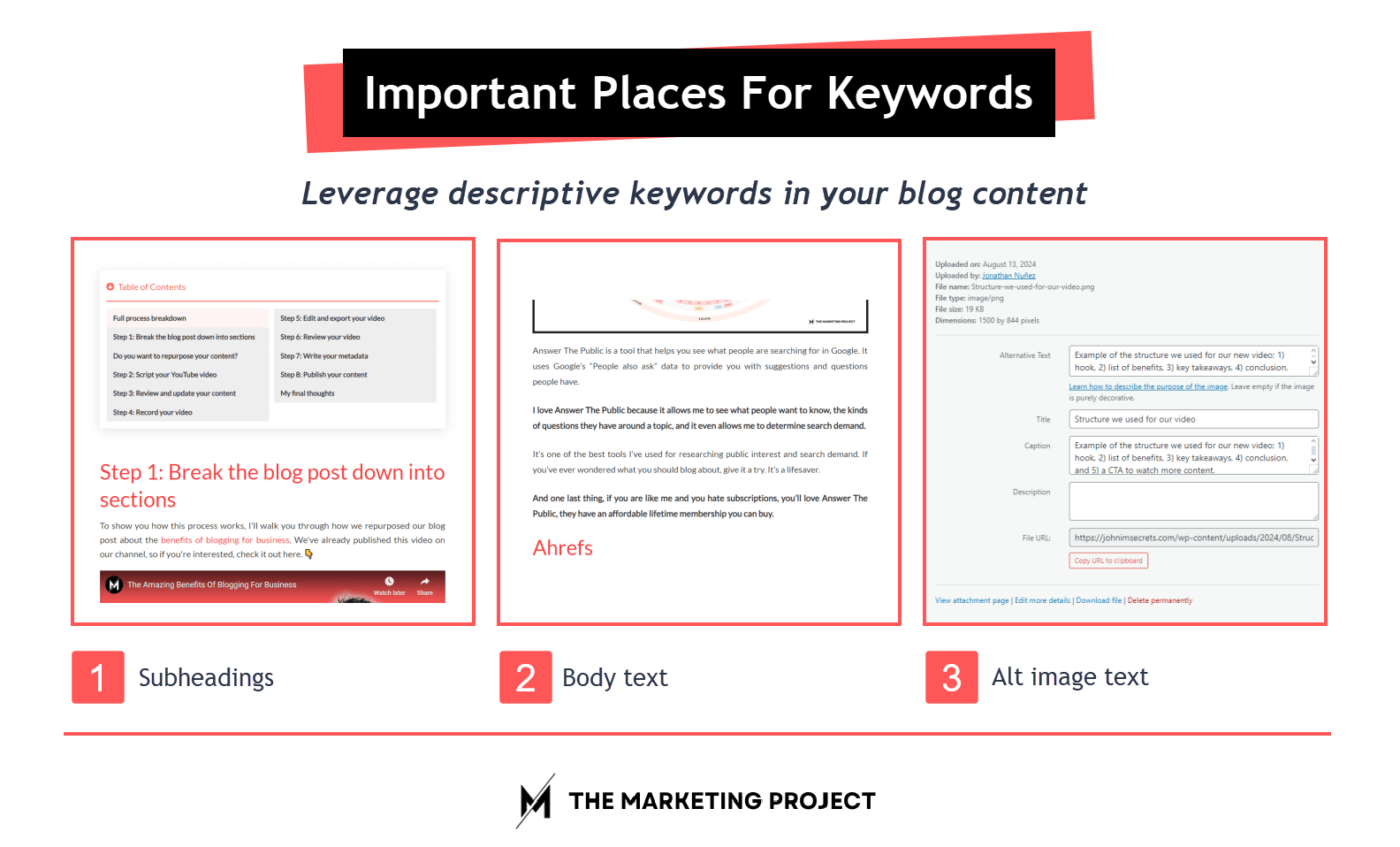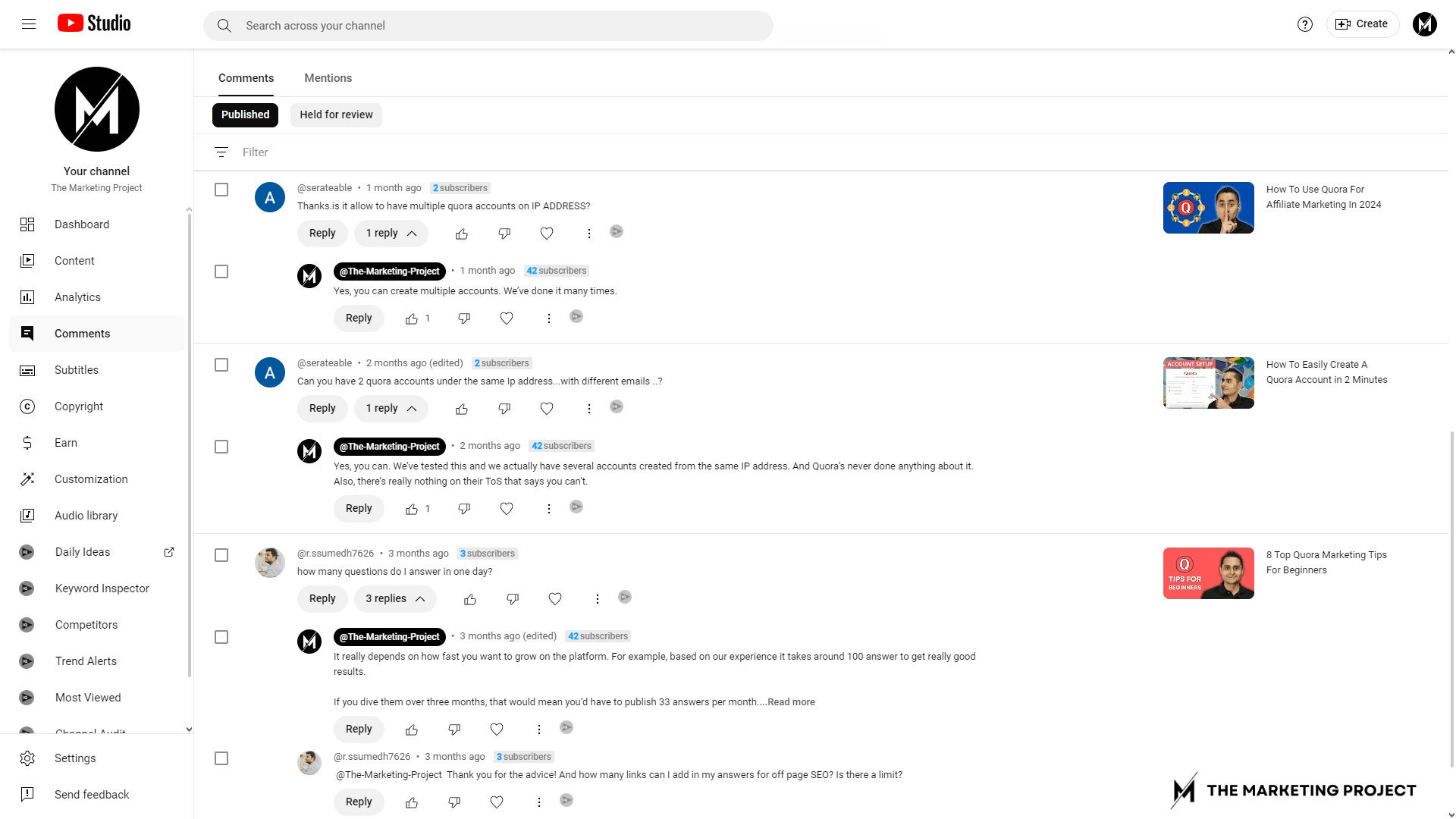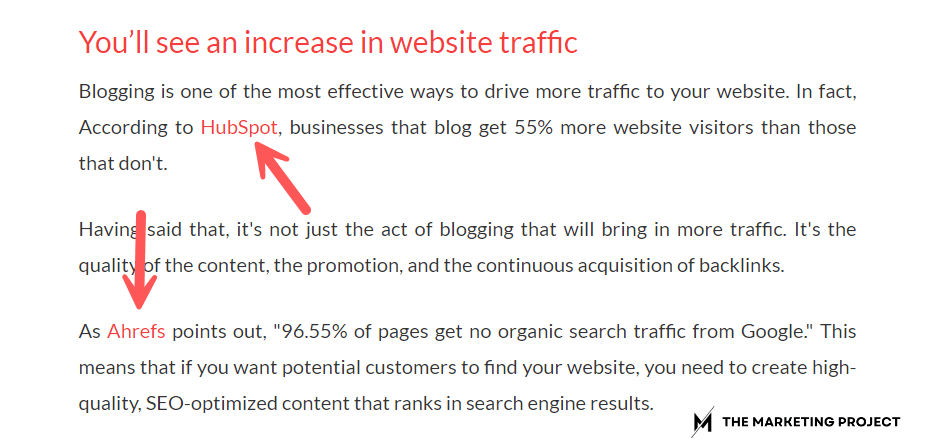Did you know that 96.55% of web pages get zero organic search traffic from Google?
Most people create content that never gets any traffic, but what if I told you there’s a way to change that?
How would that feel?
Well, in today’s blog post, I’m going to walk you through 11 common blogging mistakes that keep businesses from creating content that drives traffic and grows their blogs and their business.
Ready?
Let’s get started.
More...
1) Not choosing blog topics based on SEO research

Ubersuggest dashboard showing keyword ideas for the search "blog writing"
One of the biggest mistakes people make is choosing blog topics based on what they think people want to read, instead of what people are actually searching for. The fact is, it's very easy to assume that the topics you’re knowledgeable about are also things people care about, but that's not always the case.
The solution is to thoroughly research topics to determine which ones you should prioritize first. Just because you find topics you’re excited to write about doesn't mean you'll be able to compete in search results.
You need to consider factors like your competition's authority, whether you'll need links pointing to your page, the type of content you'll need to create, and the level of writing required to reach your target audience.
You have to dig into the data and identify the best opportunities, not just write about what you're passionate about. This is the key to creating content that actually drives traffic and leads.
2) Writing without SEO in mind
Failing to write with SEO in mind is a critical mistake that can severely limit the reach and impact of your blog content. When you don't optimize for search engines, you're essentially shouting into the void.
The simple fact is that most people turn to search engines like Google, Bing, and DuckDuckGo when they want to learn about a topic or find solutions to their problems. If your content isn't optimized to show up in those search results, you're missing out on a vast pool of potential readers and customers.
The solution?
Make SEO a core part of your content creation process.

The three places that should be optimized with descriptive keywords; 1) Subheadings, 2) body text, and 3) alt image text.
Leverage descriptive keywords in your blog post's subheads, body text, and image alt text to optimize your content so search engine crawlers can find and rank it more easily.
Interlinking your own content is also an important strategy from both a SEO and content discoverability perspective.
Think of it this way, any link to your page is like a vote. The more votes you get, the higher your search ranking and authority will be. Linking to your own content counts as a vote for yourself, and earning links from external websites can help you move up in search rankings.
Lastly, don’t forget to optimize your alt text and images. Alt text helps crawlers understand what your image is about and what it shows, so you should optimize them.
Optimized images are important because if your images are too large, they will create a poor user experience, and people will bounce from your page. There are services like TinyPNG that do a fantastic job at compressing photos.
And, if you’re wondering, “What does ‘bouncing’ mean?”—It’s basically when people search for something, open a web page, and then quickly go back to the search results because they didn’t find what they were looking for, or because the page took too long to load.
Do you want more high-quality blog content on your website?

Finding the time to consistently create high-quality blog content can be challenging, but what if you had help from professionals who have created hundreds of blog posts?
At The Marketing Project we’ve created content for all kinds of industries, from technology and cybersecurity to finance and health.
The Marketing Project is a digital marketing agency that specializes in Q&A marketing. So if you are interested in blogging for business, check us out.
We offer services like keyword research, competitor analysis, and full content writing services.
If you are interested, visit our blog writing service page. There you will be able to find all the information related to how we can help you achieve your business goals.
3) Thinking of ideas that only interest you
When you start blogging, ideas will come to you at random times. For example, when you're in the shower, when you go on a run, or while you’re on the phone. And while these ideas may come at random moments, they should never be random.
What I mean is, make it a point to position your content around what your audience wants to discover, not what you want to tell them. The reason you're blogging is to solve problems for your audience and, ultimately, to grow your business.
So, all your blog post ideas should align with those growth goals. They should be tied to issues in your industry and address specific questions and concerns your prospects have.
A great way to figure out what to blog about is to listen to what people are saying on forums and platforms like Quora and Reddit. This will give you insights into the topics that matter the most to your audience.
Also, use tools like Answer The Public to get a better picture of the language your audience uses and the specific keywords they rely on to find the content they want.
4) Not engaging with readers

Pay attention to what your readers are saying in your comment section and on social media platforms.
There’s a wealth of information you can tap into by listening to your audience. Use their feedback to create targeted content that addresses their specific issues. Your readers will appreciate the personal touch, and you'll reap the rewards of a more loyal, engaged community. It’s a win-win.
5) Not writing about specific problems your audience has
This often happens because there isn’t as much search traffic around these specific problems, so they get overlooked. However, addressing these issues can be a very good way to reach the specific people who would benefit most from the content you have to offer and the unique solutions only you can provide.
6) Only covering trending news
Chasing trending news can be a tempting trap for many bloggers, but it's a quick way to undermine the long-term success of your content strategy.
The big problem with basing your blog solely on trending news is that it becomes outdated very quickly.
Instead, focus on creating evergreen content with buzzy angles. Tackle general topics with a fresh, fun angle to establish your authority and provide lasting value to your audience.
For example, let’s say you’re writing a guide on how to fix leaking pipes. That’s an evergreen piece of content that won’t be outdated anytime soon. You can then use trendy examples that show up on the news to make your point more impactful, providing real-life examples of what happens when things go wrong.
7) Not using data to back up your claims

Data is essential for highlighting the importance of what you’re talking about. As marketers, we must rely on data to make our case and drive action. Without concrete numbers and insights, your arguments can fall flat.
So, use recent data to prove your point, and mix it with industry trends to make your content more appealing and relevant.
8) Lack of consistency
You've probably heard that the more often you blog, the more traffic you'll get to your website. While volume is important at the beginning, it's not as important once your blog is established.
You need to assess your blog's status to determine whether it's a mature website that would benefit more from updating and maintaining existing content, or a newer blog that requires a steady stream of new posts to grow.
Inconsistent blogging can confuse and frustrate your audience, causing them to lose interest and disengage from your brand.
So, if your website is new, establish a regular posting schedule and stick to it to build trust and keep your readers coming back.
9) Not attracting new subscribers

A critical error that can severely limit the growth and impact of your blog is not being able to attract new subscribers. Blogging isn’t just about getting new readers in the moment—it's about building an audience of engaged readers who will continue to support your content over time.
One of the key benefits of blogging is its ability to steadily grow an email list. Each time you publish a new post, your subscribers provide an initial boost of traffic, which then helps propel that content's long-term success and discoverability.
Successful bloggers understand that building an email list is crucial for converting casual readers into loyal fans and potential customers.
So, make building an email list a core part of your blogging strategy to continuously grow your audience and keep them engaged with your latest content.
10) Neglecting to promote blog posts
Writing your content is only half the battle. The other half is promoting and distributing it.
Ideally, every time you publish new content, you should already have a plan in place to promote it so relevant writers, like journalists and other bloggers, can take a look at your content and get a chance to cover or reference your work.
And for distribution, that’s where your email list comes in. Share it with your subscribers and on social media to get your new content in front of your existing audience.
11) Only using one medium to share your content

This is something that’s becoming more and more important because search engines are continuously changing and evolving, especially now that they have to compete with AI, and a lot of people are choosing to search for content on social media platforms over traditional search engines.
So, it’s crucial to share your content everywhere you can. The clear way moving forward is to go where your audience is being influenced. Sometimes that means blog posts, other times YouTube videos, and sometimes social media posts. You need to start thinking strategically about how you’ll distribute your content in a way that’s feasible for your business and that allows you to meet your business goals.
Keep in mind that most platforms have an algorithmic bias to reduce outbound traffic, making it harder to track conversions.
But it’s clear that we’re going back to how marketing used to be 50 years ago, where you needed to show up in as many places as possible to have a better chance of attracting prospects and customers.
Nowadays, people spend most of their time on social media, reading the news, using productivity tools and platforms like email, engaging with video and audio platforms like YouTube and podcasts, and visiting niche sites in sectors like finance, travel, and health.
And then, when they’re ready to learn more about your business, they’ll search on Google, Bing, or DuckDuckGo to explore what you have to offer.
So, repurpose and share your content across as many platforms as possible.
My final thoughts
Digital marketing is constantly changing and as such, blogging is changing too. So, take the time to develop a strategy for your blogging and content repurposing to reach as many people as possible.
You don’t have to spend hours creating different types of content, especially when you’ve already done all the research and know your audience is interested in learning more about content you’ve already created.
So, go ahead and read this content repurposing guide, it will teach you how to turn your existing content into stunning social media posts.
